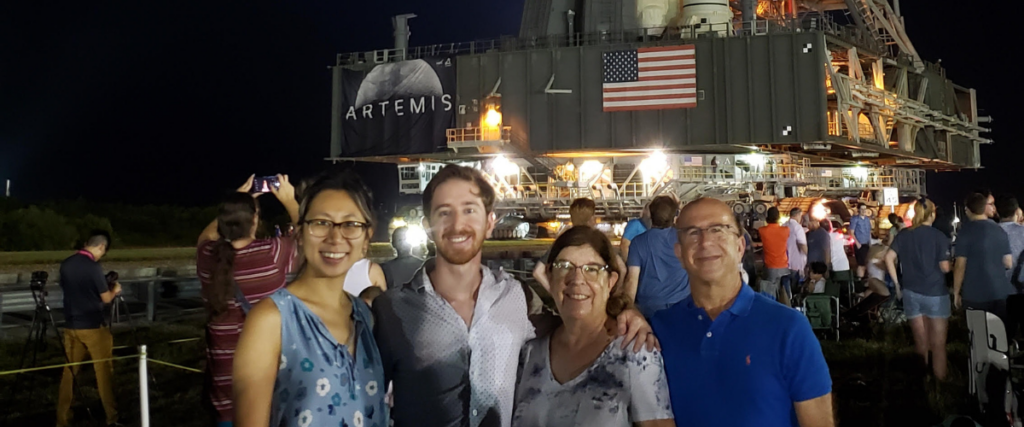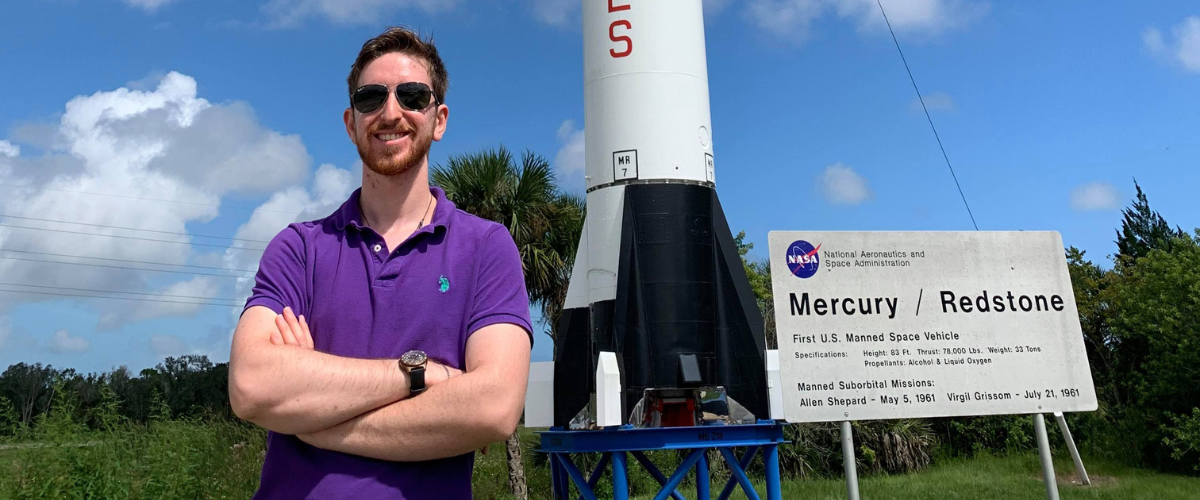When the Artemis I rocket launched into space, the world watched with wonder as NASA took the first giant step toward its goal of traveling back to the moon. The milestone was momentous and couldn’t have happened without the tireless work of UCF alumni, students and faculty.
Alumnus Brandon Kutchera, who graduated with a degree in mechanical engineering in 2018, was one of the many Knights who played a role in the Artemis I mission. Learn more about his work with NASA, his time at UCF, and the next steps of his career, in the Q&A below.
What did you do for NASA and how did you contribute to the Artemis mission?
The short answer is that I pointed cameras at the rocket. My team was responsible for the ground support cameras and associated control and recording systems used to monitor the build-up and launch of the Space Launch System. We installed, maintained and operated cameras throughout the Kennedy Space Center, though the most recognizable are those on the launch pad and mobile launcher. These cameras offered the only close-up views of the rocket during fueling and gave the launch director confidence for the final go/no-go call. Most of the close-up imagery that was broadcast during the Artemis I launch came from these cameras.
As a communication systems engineer, I was responsible for overseeing the technicians in the field and ensuring that our various systems worked together properly. Day-to-day, this could be anything from assembling and testing components to writing engineering documentation, or – on the most fun days – performing walkdowns in the field to verify equipment functionality. I primarily worked on operational television (OTV) and high-speed camera subsystems. OTV included digital cameras mounted at various locations around the center. Live video was fed back to a central control system, then broadcast center-wide and used for monitoring ongoing activities. This is the video that was broadcast as the rocket launched. High-speed cameras are film cameras mounted on the pad and mobile launcher to monitor specific points-of-interest during launch. They only run for a few seconds at liftoff and are later played back in slow motion for engineering analysis. And yes, we do still use film!
Something not many people realize is that many of the men and women who do the hands-on work –myself included – are employed by private companies. A quick tip for those looking to pursue a career in the space industry: Look beyond civil service at NASA. In my role, NASA provided guidance on how and where to install the cameras, but we installed and ran them.
What was it like to work on this project and to (finally) see it launch into space?
It was an honor to be a part of a mission so much larger than myself. I visited the Kennedy Space Center as a child and remember standing behind the barriers in the museum, wondering what it would be like to sit at one of those consoles. Walking into the firing room for the first time was a surreal experience.
What made it most exciting was seeing my work shared publicly across the news and social media. So many people are still excited by the mystique of NASA and space exploration, that I felt a responsibility to ensure that my portion of the mission was successful.
Seeing the launch live and up close was an experience that I will remember for the rest of my life. I was very fortunate to be on console in the launch control center during countdown. My lead allowed me to run outside as the clock hit zero and it was an unbelievable sight. When the solid rocket boosters lit, the sky turned bright white. Though we launched at 2 a.m., it was briefly as bright as day. I watched for about 30 seconds, before running straight back to my console to verify that all of our recordings triggered properly. It wasn’t until the drive home that the magnitude of what we accomplished really hit me. It was a bittersweet moment, seeing my years of work in action, while knowing that I may never get to experience it again.

What interested you in mechanical engineering?
For as long as I can remember, I’ve been obsessed with anything that moved. From construction trucks as a child to cars, boats and motorcycles now, I’ve always wanted to understand how mechanical things worked.
A Miata was the first big purchase I ever made. At 16, I couldn’t sign the title, but I purchased it with my hard-earned money. I still wanted to understand its workings at a deeper level, so I dug into forums and Youtube to teach myself the various systems and how to repair issues that arose. I taught myself every job from changing the oil to replacing safety critical components, trusting that my handiwork would get me home. This passion led me into engineering.
As a visual learner, I found that physics and mechanical systems made sense to me. Other engineering disciplines required visualizing how components worked together without being able to see their interaction, like electrical engineering where the flow of electrons is not visible. I found it much easier to understand mechanical concepts, like the meshing of gears, because I could see them in action.
Why did you choose UCF for your undergrad degree?
UCF is known throughout the state for the quality of its engineering programs. Growing up in South Florida, I knew that I wanted to stay in state for my bachelor’s degree, but that it was worth leaving home to receive a high-quality education. Much of my school research centered around engineering programs, so UCF immediately appealed to me. I loved the size of the school because it gave me an opportunity to find my niche. I was also interested in participating in the Society of Automotive Engineers and seeing their car during my tour helped to solidify my decision.
It didn’t hurt that UCF allowed freshman to have cars on campus and I absolutely was not ready to get rid of my Miata to attend school!
Now you are heading into a grad program at Yale. What will you be studying and what are the next steps for your career?
This fall, I am starting my MBA at Yale. Engineering gave me the resources to solve complex, technical problems and now I’d like to increase my impact by working in big-picture strategy roles. The MBA offers exposure to business concepts that will help me advance my career and Yale offers a network of smart, talented, driven people who can help me accomplish my goals. I also like to joke that I’m really just attending to learn to talk to people.
I will be using this as an opportunity to pivot to strategy consulting. In this role, I will be advising executive leaders of global organizations on solving the most pressing issues their firms face, such as how to best incorporate artificial intelligence into existing business operations. I aim to gain exposure to a wide range of business techniques and industries by working on a variety of fast-paced projects. Ultimately, my aim is to apply the analytical, data-based problem-solving approach from engineering to global-scale problems.
- Published by Marisa Ramiccio
